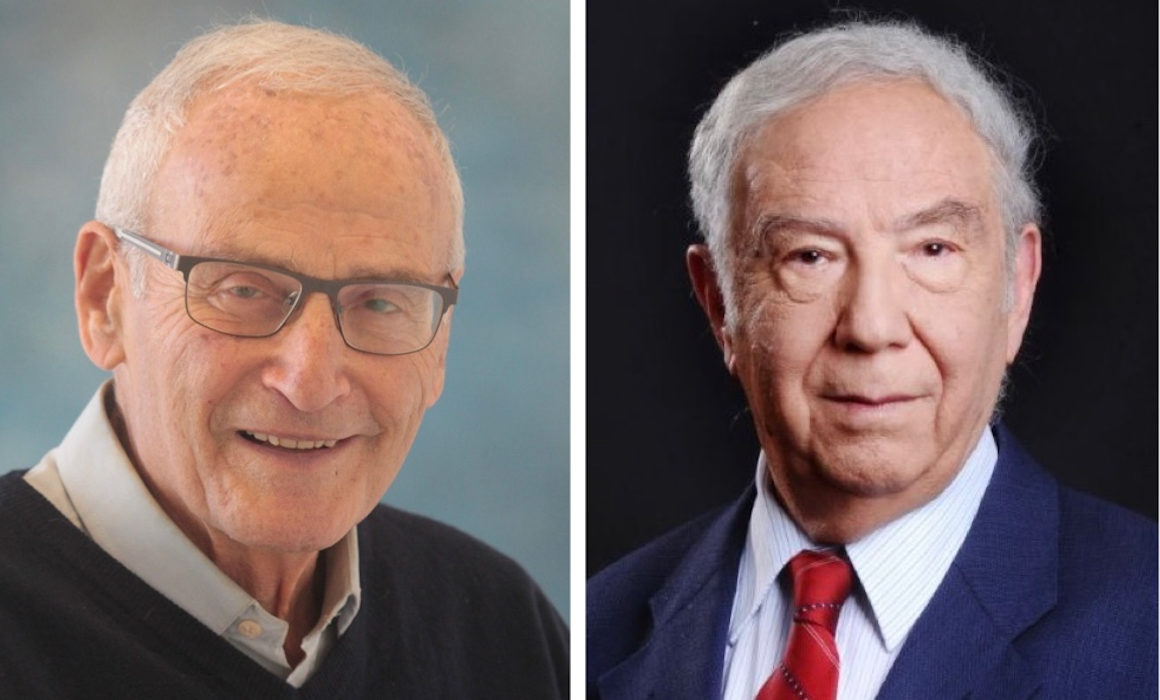Pictured Above / Prof. Emeritus Joshua Zak (left), Prof. Emeritus Yoram Palti (right)
Israel’s Minister of Education, Dr. Yifat Shasha-Biton, recently announced that two Technion faculty members have been recognized with prestigious Israel Prizes for their contributions to their field and society.
Professor Emeritus Yoram Palti of the Technion’s Rappaport Faculty of Medicine is the winner of this year’s Israel Prize for Entrepreneurship and Technological Innovation, and Professor Emeritus Joshua Zak of the Department of Physics has been awarded the 2022 Israel Prize for Physics and Chemistry Research. Prof. Palti was given the honor for a non-invasive, highly selective method for electrical treatment of several types of cancer, while Prof. Zak was recognized for the development of mathematical tools such as the “Zak Transform” and the “Zak Phase” for decoding electrical conductivity in magnetic fields.
Technion President Professor Uri Sivan said: “We are proud and absolutely delighted by these important recognitions. To have two Israel Prizes awarded to Technion researchers in one week has us bursting with pride!”
He continued: “Prof. Palti’s work is an excellent example of the integration of engineering and medicine — integration that is among the Technion’s most distinctive hallmarks. Prof. Palti is an outstanding model of the rare ability to translate science into applications that are beneficial to people by combining profound research with an entrepreneurial spirit. Prof. Zak is a member of the generation of giants that founded the Department of Physics at the Technion, thus laying the foundations for theoretical physics in Israel. His research has led to a breakthrough in the understanding of fundamental phenomena that are at the forefront of quantum mechanics, while contributing greatly to practical engineering applications.”
More on Professor Palti’s Work
Alongside his original research work and management positions at the Faculty of Medicine and at the Rappaport Research Institute, Prof. Palti dedicated himself to translating his innovative research to the clinical field. As a result, he became a serial entrepreneur — founding a succession of companies, including Carmel Biosensors (monitoring glucose among diabetes patients), EchoSense (diagnosing heart disease), O2Cure (respiratory assistance and artificial lungs), and BetaVive (treatment for diabetes).
The highlight of Prof. Palti’s research and entrepreneurial activities is NovoCure, the company he founded in 2000, which developed an innovative treatment for cancer patients. The treatment is based on special electric fields that attack the cancerous cells without harming surrounding healthy cells, and therefore do not produce side effects or other risks. To date, approximately 20,000 patients have been treated with NovoCure’s technology in around 250 medical centers around the world.
More on Professor Zak’s Work
Professor Joseph Avron, staff member at the Technion’s Department of Physics, said, “Prof. Zak’s story is one of the meteoric rise of a boy who was almost completely unschooled, and it was only thanks to his phenomenal talent that in just a couple of years he succeeded in catching up, completing the entire curriculum imparted to children by the educational system over a 12-year period.”
At the age of 12, Prof. Zak and his family were sent to the ghetto, and later, he was deported to forced labor camps and a concentration camp, years in which he lost both parents and two of his siblings. As an adolescent, Zak was forced to join the Death March to the west, and was released by and immediately recruited to the Red Army – all before he had reached the age of 16. Following his discharge in 1948 he returned to Vilna and began to attend high school, graduating with honors despite having missed many years of schooling due to the war and his military service. He completed his studies in Physics with distinction at Vilnius University in 1955.
Prof. Zak has many achievements in physics to his credit, two of which are named after him: the Zak Transform, which is presently used in signal processing, and the Zak Phase — a unique 1D crystal phase, which he published in an article in Physical Review Letters in 1989.


